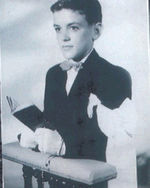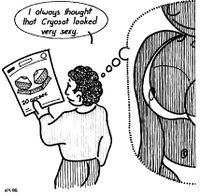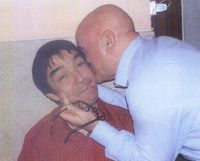User:Claude.Garrido
“Do not judge a man by his cover”
– Claude on hairstyles
“A good email is a printed email”
– Claude on a quest to get rid of the Amazon Forest
“On va pas enculer les mouches”
– Claude on the importance of abstraction in software design (ask the nearest Frenchman for translation)
“Let's not re-invent the wheel”
– Claude on proposals emanating from any Southern Europe ESA establishment
“Mac or PC, what's the difference ?”
– Claude on a limb showing his actual ignorance of personal computing core issues
“Exactly !”
– Bill Gates on his pile of cash, amazed he finally fooled someone
“I always liked his hairstyle”
– Gandhi on Claude
The Early Years[edit | edit source]
Claude was born on 6 april 1947 in Mont-de-Marsan in the French Department of Landes [editor's note: this is where the locals mistakenly believe they produce the best Foie Gras in the world]. Very little is known to us about this early period of his life [editor's note: very likely because, realizing the French Department of Gers actually produces the best Foie Gras in the world, Claude wisely attempted to erase his connections to Landes].
The Formative Years[edit | edit source]
He then studied at various schools in Mont-de-Marsan, then at the Arcachon High School, earning his Baccalaureat with specialties in Maths, Physics, and Oysters Opening Techniques. Followed several years of University in Canada on a grant. Claude did not know any English at the time, but despite his difficulties mastering the language of Shakespeare, he decided that Canada was the right place to learn "soft-ouère".
The Religious Education[edit | edit source]
Claude also followed proper religious education, which he is very proud of... as you might all know, a predisposition to a scientific career ? After all: even Einstein believed in God !
So it may come as a surprise that Claude developed a devotion to the art of the "Contrepèterie" (spoonerism), a verbal art often offending the Church. His first "Contrepèterie" ("Il fait beau et chaud") has been cited so many times by the famous and hilarious Belgian actor Jean-Claude Van Damme.
Anyway despite his repeated offenses, Claude's priest has kept fond memories of his "bouille incroyable" (a true angel's face).
ESA For Ever[edit | edit source]
Early in his professional life, Claude joined the European Space Agency (ESA), at ESTEC, the Technical and Research Center in Noordwijk, Netherlands. He remained there until his retirement, probably because of his repeated and failed attempts at learning the Dutch language. Claude does not give up easily.
ERS-1[edit | edit source]
ERS-1 was a scheme under which thousands of engineers throughout Europe explained to their wives that they had to work late. Not only late, they even had to travel to exotic places. Sorry and all that. Claude, who had previously been gainfully employed in some other part of ESTEC, decided that he should join this club. Unfortunately he joined the wrong Chapter and so missed out on the social training meted out to other Chapters. But he did his best and brought a certain level of style to the poor wretches labouring there. In thoses days where arithmetics was performed using slide rules [editor's note: check in a local museum for examples of "slide rules"] Claude stuck his neck out – he knew how to drive a computer. Toggle switches, incandescant 8-segment displays, paper tape and stuff like that. He could get his hands dirty.
One of Claude's 'babies' (actually one of Mr. Capart's babies) is the Decentralized Test Facilty (DTF) in the ESTEC Battery Test Centre. Finn Aidt did the 'dirty job' (the coding). The software is still going strong. However, Hewlett Packard and Agilent unfortunately pulled the plug, stopped the hardware production and the support for BASIC. Therefore we were forced to look for another suitable hardware and a suitable software. This time there was no easy inhouse fallback solution and we had to look for an outside contractor who developped LuaView, based on the Brasilian scripting language LUA (Univerisity of Sao Paulo) and LabView.
Before ERS[edit | edit source]
In the late 70ties, Claude was a known figure in the world of spacecraft simulation. These were the days of real computer programs and real programmers. At that time computer programs had mass: A typical ‘patch’ weighed in at more that 50 kg and it took considerable strength to shift the massive bundles of connected wires in and out of the main computer. Perhaps that is the explanation Claude and many of the wizards working in that laboratory later took up windsurfing - as computer technology advanced into digital computers that are pretty useless to keep you fit.
At that time first massive digital computers started to invade ESTEC: Computers running with the clock speed of a Cuckoo Clock, 8K of Ferrite memory and a few MB of disk – all shared between 30+ analysts trying to squeeze the latest twist of quaternion equations or data acquisition system into an already helplessly overloaded computer. These were the times where Claude earned the name ‘Octopus’, a term coined by another Claude, called ‘BouBou’ (the name ‘Claude’ name was obviously already taken, of course). BouBou had noticed that any unused computer equipment somehow would drift naturally through the laboratories to gradually become an essential part of some set-up of Claude. BouBou did not fully appreciate this, claiming only an Octopus would need 8 keyboards around him.
Do you remember computers had panels full of flashing light at those times? Well, this was the preferred user interface for Claude. He used this to display anything important in his computer programs, and was famous for being able to tell precisely what was going inside the computer by casually observing the flickering of these lights. Claude spent many an evening scratching his head in front of such computer panels solving the intricacies of computer programming – the story even goes that it the explanation he lost a lot of hair in the early years…
With these wonderful machines in house, Claude soon entered a new era of computer simulation. A spacecraft called the International Solar Polar Mission was born and needed expert help. Octopus, soon became one half of what the British prime contractor referred to as the ‘dynamic duo’, that put the mathematics of this strange spacecraft, spinning around itself like a yoyo flapping is long cables, into the first real time simulator ready to test if this could be controlled in space. In the middle of this, a peanut farmer in US became the president and decided to cut NASA budgets. NASA in turn decided that the best place to cut down was this mission done with ESA. Well, that is another long story, but the end was a happy one: The spacecraft changed name to Ulysses, and has been orbiting the Sun happily ever after, and performing exactly as predicted by the ‘dynamic duo’.
Things moved on and soon some of the space companies (this was at the times when there where much more that 2 space companies in Europe) started to put computers inside spacecraft and to dabble with writing programs for them. In order not have computer professionals steal the work, the companies choose to write the programs in languages nobody else knew about (HAL/S, Ada,…), or even to invent new programming languages of their own (NEBAL). As a double protection against professional IT, the companies also mostly choose to have specialist in Quantum Physics or Organic Chemistry to make the delicate pieces of computer programs that control everything on a spacecraft. This started a mess that still lives and thrives well today and has nearly become the standard approach in some space projects.
Claude soon spotted the challenges in that and started checking some of the software the ‘bandits’ were seriously considering to fly on the spacecraft. One company once tried to challenge Claude’s professional authority, claiming a bug he has detected was due to a Cosmic Ray traversing the computer and not a bug in their program. Claude with his usual flair of being respected without being rude, replied to the company that he was close to a major discovery in quantum physics: He was now able predict with high accuracy precisely when a cosmic ray would traverse the laboratory and crash the their program. Well, after some reflection the company gave in, recognising that a bug in their software would be a more probable explanation after all. The company did not try new tricks for a long time – and Claude earned professional respect that would never leave him since.
After many years with this, he finally decided to quit and move on to the calmer waters, where you work on only one space project at a time: He became part of ERS-1, the first attempt to put a big radar to get all weather observations of our gardens.
Embedded Software Section[edit | edit source]
Claude was appointed Head of the Embedded Software Section. As he called it himself at the time: "I joined this group because it meant doing software in bed !". No wonder Claude always struggled to settle in a stable relationship.
Envisat-1[edit | edit source]
[editor's note: we have not found anybody who worked on the Envisat-1 Ground Segment AND remembers having done so...]
Envisat-2[edit | edit source]
Hey, wasn't one enough ? I thought so...
Cryosat[edit | edit source]
It was common knowledge that Claude had a special interest for CryoSat. Maybe something to do with his preference for doing software in bed (see earlier section) ?
Other Projects[edit | edit source]
Claude also had a temporary passion for Astronomy. He even discovered a Red Dwarf while cleaning an old observation instrument.
Earth Observation System Division[edit | edit source]
The Wine[edit | edit source]
Bordeaux, what else ?
Claude the Sportsman[edit | edit source]
Actually he never touched a football ball in his life (or so he says) but...
The Windsurfing[edit | edit source]
Hair flowing in the wind. He is still a living windsurf legend around the lake of Sanguinet (South-west of France). Like the "Filles de Camaret", the female pensioners of Sanguinet may spend entire days on the lake banks to see this Californian-style surfer dragging and cooling a few bottles of white wine behind his windsurf. Fresh white wine from Entre-deux-mers with oysters is his first motivation to windsurf far before his groupies from the "Maison de Retraite Communale de Sanguinet" !!!
The Flying Almost-Dutch-Man[edit | edit source]
After having spent most of his youth (and more) trying to get lawn mowers to fly, on a bright and sunny summer day Claude discovered a new way of flying. He got robbed by some paragliding instructors who made him spend half a month salary for a five minutes tandem flight ten meters above the sand of the dune du Pyla close to his home country. It was a major revelation: not only had destiny disclosed a new way to enjoy life that was causing feelings and sensations similar to making sex with a gorgeous lady, according to wind conditions it could last much longer!
The decision was quickly taken: no more dubious photographs in the corridors. Claude was telling whoever wanted to listen: "C'est décidé, dès que je suis en retraite, je m'envoie en l'air avec un Mission Manager. Il suffit que j'en trouve un qui fasses du parapente." Inch Allah
The Controversy[edit | edit source]
There was an early hint with his assiduity to religious studies. The rapid ending of his marriage (to a woman) was another clue.
Then the rumor started spreading, and of course the many pictures that soon starting flooding the Internet did not help...






